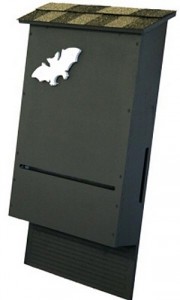I live in Virginia. Through the mosquitos that share these wetlands (swamps!) with us we are at risk from West Nile virus, Eastern Equine encephalitis, La Crosse encephalitis, and St. Louis encephalitis. They’re all as horrible as they sound. Who knows what diseases you are at risk from where you live!
Which is why I like the bats that live in my trees. They gobble up the mosquitoes bugging my property. And they operate for three seasons! Saving me from bugs!
In case you don’t have bats already, here are some ways to attract and keep them. This is a nifty project for the winter so you’ll be all set and ready to go next Spring.
1. Build a bat house.
When you install a bat house near your home, you invite bats to move in. Which is great, as just one of these  little flying mammals can eat more than a thousand mosquitoes in a single night! They also eat bugs that can damage gardens and farm crops. And bats are green: More bats mean less pesticide and less poison keeps the water table cleaner.
little flying mammals can eat more than a thousand mosquitoes in a single night! They also eat bugs that can damage gardens and farm crops. And bats are green: More bats mean less pesticide and less poison keeps the water table cleaner.
Constructing and installing bat houses is perhaps the easiest and least-expensive way to support bats on your farm. Plywood (1/2-inch four-ply) or cedar make excellent choices for construction.The booklet below shows you how to build one — it’s not difficult and factors in design, location, sun exposure and coloration variations of the house for different regions of the United States. follow the instructions about how high the bat house should be placed – you need to defend them against natural predators, such as snakes.
2. Old barns are great
Old, wooden barns and sheds are perfect bat habitats. The wood is naturally worn, making it easy for bats to traverse. Rather than tearing down an old barn, leave part of the structure standing and modify it to accommodate bats. Bats want to roost tucked between boards that are 3/4 inch to 1 inch apart and roughly scored so they’re easy to cling to. Bats already roosting in working barns can be left alone.
3. Mimic or preserve native habitats.
Restoring native habitat is the way to go to attract and keep bats. They like water (like ponds, wetlands, woodlands and native species provide the right conditions for the insects bats need to consume to survive.
4. Hollowed out trees
Bats are adaptable and will roost in hollow trees.
Bats are among the cheapest and most effective ways to keep down annoying, disease-carrying mosquitoes. And that’s where the bat box comes in.
The benefits of having bats in your neighborhood extend beyond mosquito control. They also eat bugs that can damage gardens and farm crops. More bats mean fewer pesticides and that’s good for your health, too. Fewer pesticides also help keep water systems cleaner.
The great thing about a bat box is that once a bat moves in, you’ll have mosquito protection – and the other benefits – no matter what happens. If there’s an outbreak of West Nile virus, you’ll have less to worry about because your bats will be reducing the risk!
No good at D.I.Y? (You really should give it a try, after all how badly can you mangle a bat house?)
Easy-to-assemble or re ady assembled bat boxes are available at most local hardware stores like Lowes or Home Depot for $9.99 as well as local home and garden centers. We saw a super-swanky Victorian-themed one online at Planet Natural for $90!
ady assembled bat boxes are available at most local hardware stores like Lowes or Home Depot for $9.99 as well as local home and garden centers. We saw a super-swanky Victorian-themed one online at Planet Natural for $90!
No they’re not infected and no, they won’t fly into your hair
Most of us have watched the movies and worry that bats carry disease like rabies, or they’ll suck our blood. Like most mammals, bats can get rabies, but it’s very rare. Bats – even rabid bats – don’t attack humans, so your risk of getting sick from a bat is very nearly zero. Bats won’t get tangled in your hair or suck your blood. The benefit of bats is they actually reduce diseases.
Thanks to Bat Conservation International
